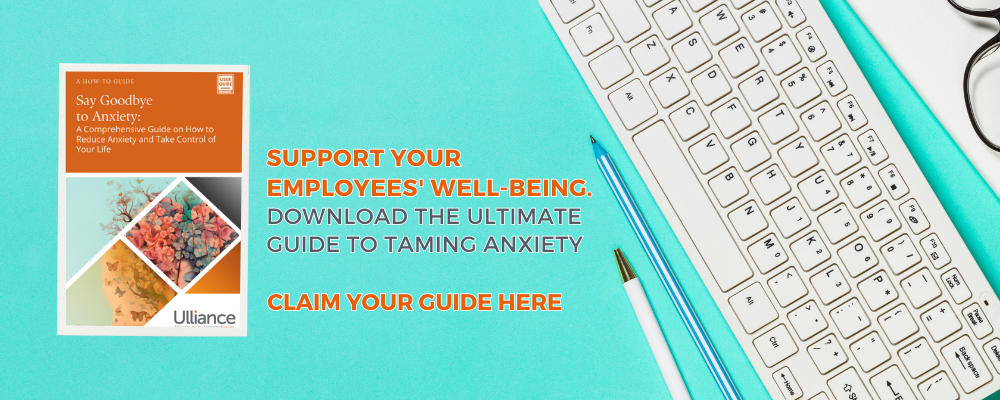Work can sometimes be a stressful place for almost everyone. In fact, 85 percent of respondents in Mental Health America’s 2021 Mind the Workplace report said that job stress affected their mental health.
Persistent workplace anxiety, however, is far more than just feeling overwhelmed occasionally. Persistent anxiety can have a significant impact on an individual's mental and physical health, as well as their ability to perform in the workplace.
According to the National Institute of Mental Health, anxiety disorders are the most common mental illness in the United States, affecting over 40 million adults each year. Untreated anxiety can lead to a range of negative outcomes, including depression, substance abuse, and even suicide.
"64% of employed adults in the United States feel that work is
a significant source of stress in their lives."
~American Psychological Association
In the workplace, persistent anxiety can lead to decreased productivity, increased absenteeism, and difficulty collaborating with colleagues. It can also impact an individual's career advancement and lead to missed opportunities for growth and development. Therefore, it's crucial for employers and employees to prioritize the management and treatment of anxiety in the workplace to ensure a healthy and productive work environment.
Signs of Workplace Anxiety
The terms "anxiety at work" and "workplace anxiety" are often used interchangeably, but there is a subtle difference between the two.
Anxiety at work refers to the experience of anxiety symptoms while in the work environment. This can include feeling anxious before a meeting or presentation, experiencing performance anxiety while working on a project, or feeling stressed due to a high-pressure work environment.
On the other hand, workplace anxiety refers to a broader concept that includes the impact of work-related stressors on an individual's mental health and well-being. Workplace anxiety can be caused by a range of factors, including workload, job insecurity, conflicts with colleagues, and poor work-life balance.
In other words, anxiety at work is a specific experience of anxiety symptoms while engaging in work-related activities, while workplace anxiety refers to the broader impact of work-related stressors on an individual's mental health.
Anxiety can manifest in a number of different ways in the workplace:
● Difficulty concentrating or completing tasks
● Feeling overwhelmed or stressed
● Irritability or mood swings
● Physical symptoms such as headaches, muscle tension, or stomach issues
● Avoidance of certain tasks or situations
● Difficulty sleeping or fatigue
● Decreased job satisfaction or motivation
● Increased absenteeism or tardiness
● Conflict with colleagues or supervisors
● Feelings of inadequacy or self-doubt
● Increased reliance on alcohol or drugs as a coping mechanism
● Panic attacks or excessive worry about work-related issues
It's important to recognize and address anxiety in the workplace because it can impact both the individual's well-being and the productivity of the entire workplace.
Addressing Anxiety in the Workplace
Anxiety in the workplace can have serious consequences for both employees and employers. While some level of stress can be motivating, chronic stress and anxiety can have negative effects on both physical and mental health.
For employees, chronic anxiety can lead to burnout, decreased job satisfaction, and even physical health problems. For employers, anxiety can lead to decreased productivity, increased absenteeism, and higher healthcare costs.
Workplace culture can play a significant role in contributing to or alleviating workplace anxiety. A culture that prioritizes open communication, support, and work-life balance can help reduce stress and anxiety among employees.
“Job stress is estimated to cost the US industry more than
$300 billion in losses due to absenteeism, diminished productivity, and accidents."
~American Institute of Stress

6 steps employers can take to help address anxiety in a positive way
-
create a supportive work environment- employers can take steps to create a work environment that is supportive of employee well-being. This can include offering flexible work schedules, providing resources for mental health support, and offering an employee assistance program.
-
encourage self-care- employers can encourage employees to prioritize self-care by promoting healthy habits such as exercise, healthy eating, and taking breaks throughout the workday.
-
provide training and resources- employers can provide training and resources to help employees manage stress and anxiety in the workplace. This can include workshops on stress management techniques or access to an employee assistance program.
-
foster positive relationships- employers can foster positive relationships among colleagues by encouraging teamwork and collaboration. This can help create a sense of community and support within the workplace.
-
offer employee wellness programs- employers can also consider implementing employee wellness programs, such as mindfulness training, yoga classes, or stress reduction workshops, to support employee well-being and reduce workplace anxiety.
-
address workplace stressors- employers can address workplace stressors by identifying the root causes of anxiety and taking steps to address them. This may include reevaluating workload, addressing conflicts among colleagues, or providing additional support or resources.
Employers can work with an employee assistance program (EAP) to provide confidential and professional support to employees experiencing anxiety in the workplace. EAPs can offer a range of services, including counseling, support groups, and stress management programs, to help employees manage their anxiety and improve their overall well-being.
Employers can also work with EAPs to provide training and resources to managers on how to identify and support employees who may be struggling with anxiety or other mental health issues. By partnering with an EAP, employers can demonstrate a commitment to supporting their employees' mental health and creating a healthy and productive work environment.
5 Ways individuals can manage anxiety in the workplace
-
take breaks- it's important to take breaks throughout the workday to help manage stress and anxiety. This can include taking a walk outside, practicing deep breathing exercises, or simply stepping away from your desk for a few minutes.
-
practice coping techniques- these practices can help you stay present in the moment and reduce feelings of overwhelm.
● Mindfulness techniques such as meditation or yoga
● Getting outdoors in nature
● Getting some exercise
● Grounding techniques, such as listening to calming sounds or smelling pleasant aroma
-
set boundaries- setting clear boundaries between work and personal life can help prevent burnout and manage stress. This may include setting limits on email or work-related communication outside work hours.
-
seek support- It is crucial to prioritize your mental well-being, especially in the workplace. If you ever find yourself feeling overwhelmed or hopeless, remember that seeking help is a sign of strength. One way to address anxiety in the workplace is by reaching out for emergency support from a mental health professional. This can be done by talking to a manager or a trusted colleague who can provide guidance and support. Additionally, utilizing an employee assistance program can also offer valuable resources and support. Remember, taking care of yourself is essential for your job performance, and seeking professional help when needed is a proactive step towards maintaining your mental health and well-being.
- TO DISCLOSE YOUR ANXIETY TO YOUR EMPLOYER OR NOT-
Deciding whether or not to disclose your anxiety to your employer is a personal choice that should be carefully considered. It's important to weigh the potential benefits of sharing this information against any concerns you may have. By informing your employer about your anxiety, they may be able to provide the necessary support and accommodations to help you manage your symptoms effectively in the workplace. These accommodations could include flexible work schedules, access to mental health resources, or involvement in an employee assistance program. Disclosing your anxiety can also help your employer better understand any changes in your performance or behavior, enabling them to offer appropriate assistance and support.
However, it is crucial to assess your comfort level and trust in your employer before making this decision. It's understandable that you may have concerns about potential discrimination or negative consequences. Rest assured, the law is on your side. It is illegal for employers to discriminate or take adverse actions against you based on your mental health.
It's worth noting that under the Americans with Disabilities Act (ADA), severe anxiety that significantly impacts your ability to work is considered a disability. While you are not obligated to disclose your condition, it's important to understand that without disclosing it, your employer may not be aware of the need for accommodations. This means they may not be able to provide the necessary support to help you thrive in your role.
Managing work anxiety is a crucial aspect to consider, as poor performance can lead to potential repercussions. Taking proactive steps to address your anxiety can greatly contribute to your overall well-being and job satisfaction. If you are an employer or manager, it's important to create an environment that supports employees with anxiety, and here are some suggestions on how you can achieve that. If you are an employee, remember that seeking support from your employer can lead to a healthier and more productive work environment.
Ultimately, the decision to disclose your anxiety to your employer rests with you. Reflect on your comfort level, consider the potential benefits and legal protections, and engage in open and confidential conversations with your supervisor or HR department. Your mental health should be a priority, and by seeking support, you can foster a workplace that values and supports your well-being.
Anxiety in the Workplace is Real
Anxiety in the workplace is a real and growing problem that affects both employers and employees.
Employers can take steps to support their employees' mental health and well-being by creating a supportive work environment, providing resources for mental health support, and offering training and resources on stress management techniques.
Employees can manage anxiety in the workplace by taking breaks, practicing coping techniques, setting boundaries, and seeking support when needed.
By working together to address this issue in an open, honest way, we can all make meaningful strides toward helping to ensure that our workplaces are safer and more supportive for everyone.
When you partner with Ulliance, our Life Advisor Consultants are always just a phone call away to teach ways to enhance your work/life balance and increase your happiness. The Ulliance Life Advisor Employee Assistance Program can help employees and employers come closer to a state of total well-being.
Investing in the right EAP or Wellness Program to support your employees will help them and help you. Visit https://ulliance.com/ or call 866-648-8326.
The Ulliance Employee Assistance Program can address the
following issues:
• Stress about work or job performance
• Crisis in the workplace
• Conflict resolution at work or in one’s personal life
• Marital or relationship problems
• Child or elder care concerns
• Financial worries
• Mental health problems
• Alcohol/substance abuse
• Grief
• Interpersonal conflicts
• AND MORE!
Have some questions about our services? Book a quick meeting below!
References:
How to Deal With Anxiety at Work, WebMD
https://www.webmd.com/anxiety-panic/features/workplace-anxiety
Mind the Workplace - MHA Workplace Health Survey 2021,
https://mhanational.org/research-reports/2021-mind-workplace-report
Stress in America™ 2020: A National Mental Health Crisis, American Psychological Association
https://www.apa.org/news/press/releases/stress/2020/report-october
Workplace Stress, The American Institute of Stress https://www.stress.org/workplace-stress
Your Guide to Managing Workplace Anxiety, Healthline ,https://www.healthline.com/health/anxiety/workplace-anxiety

